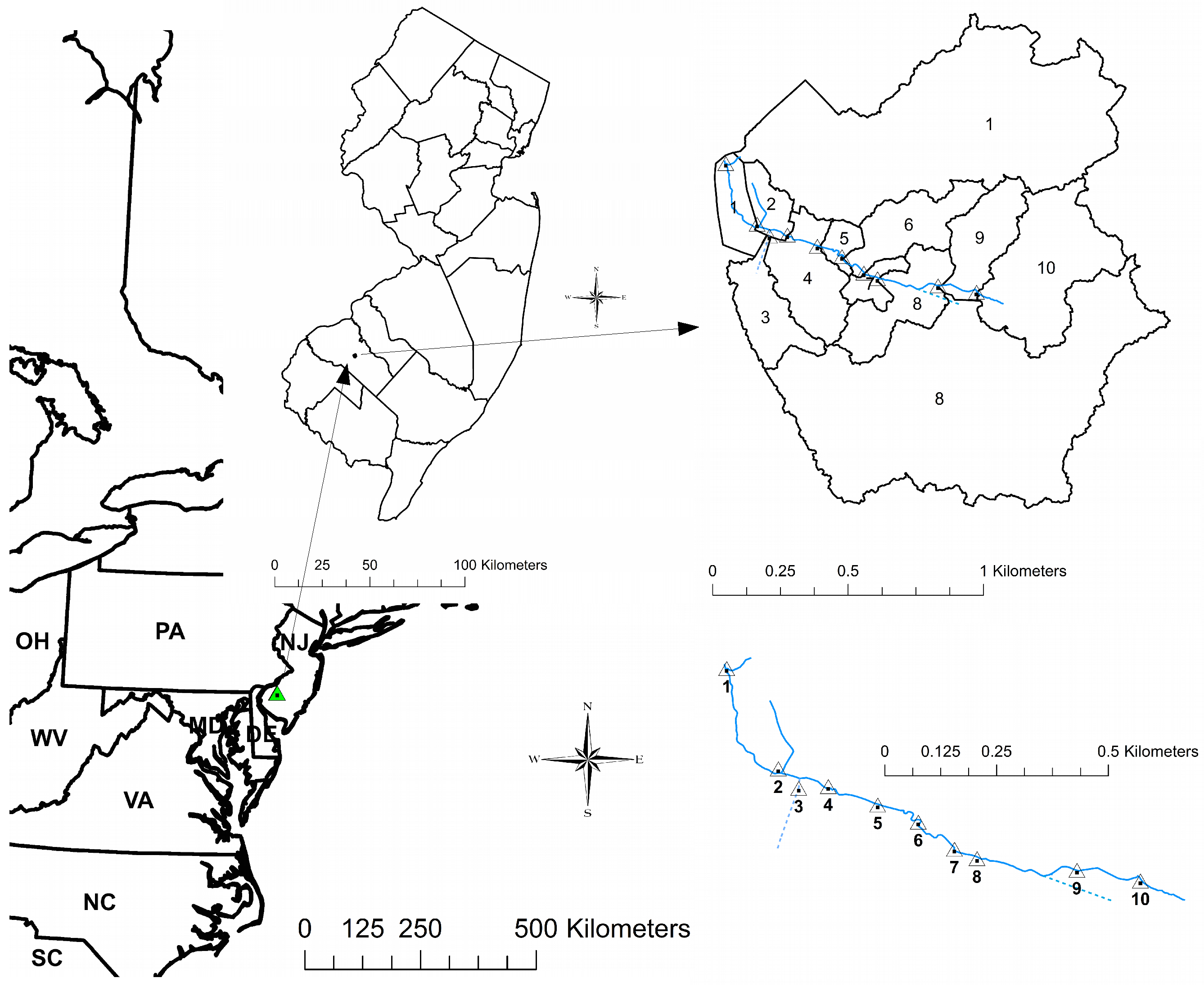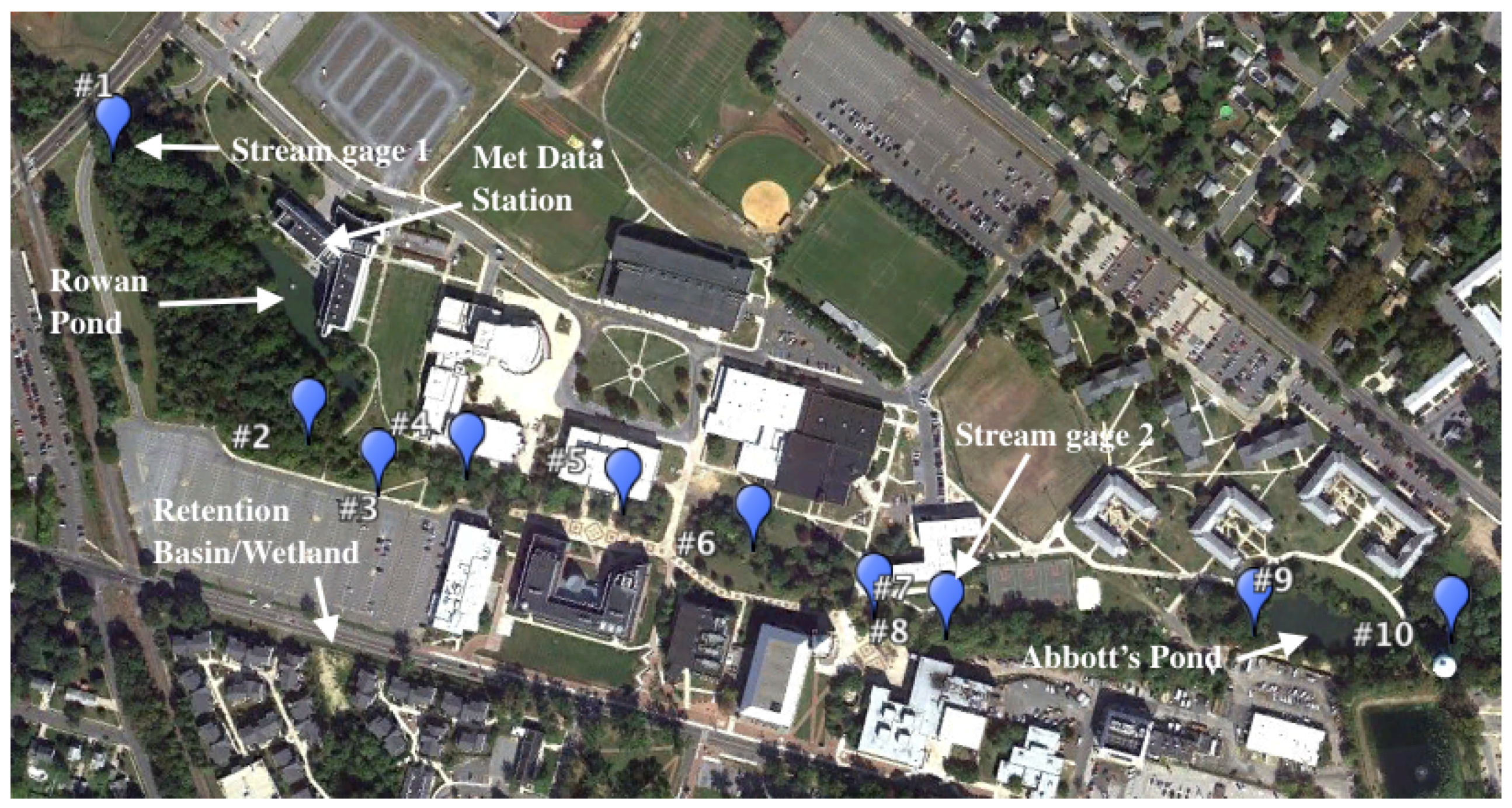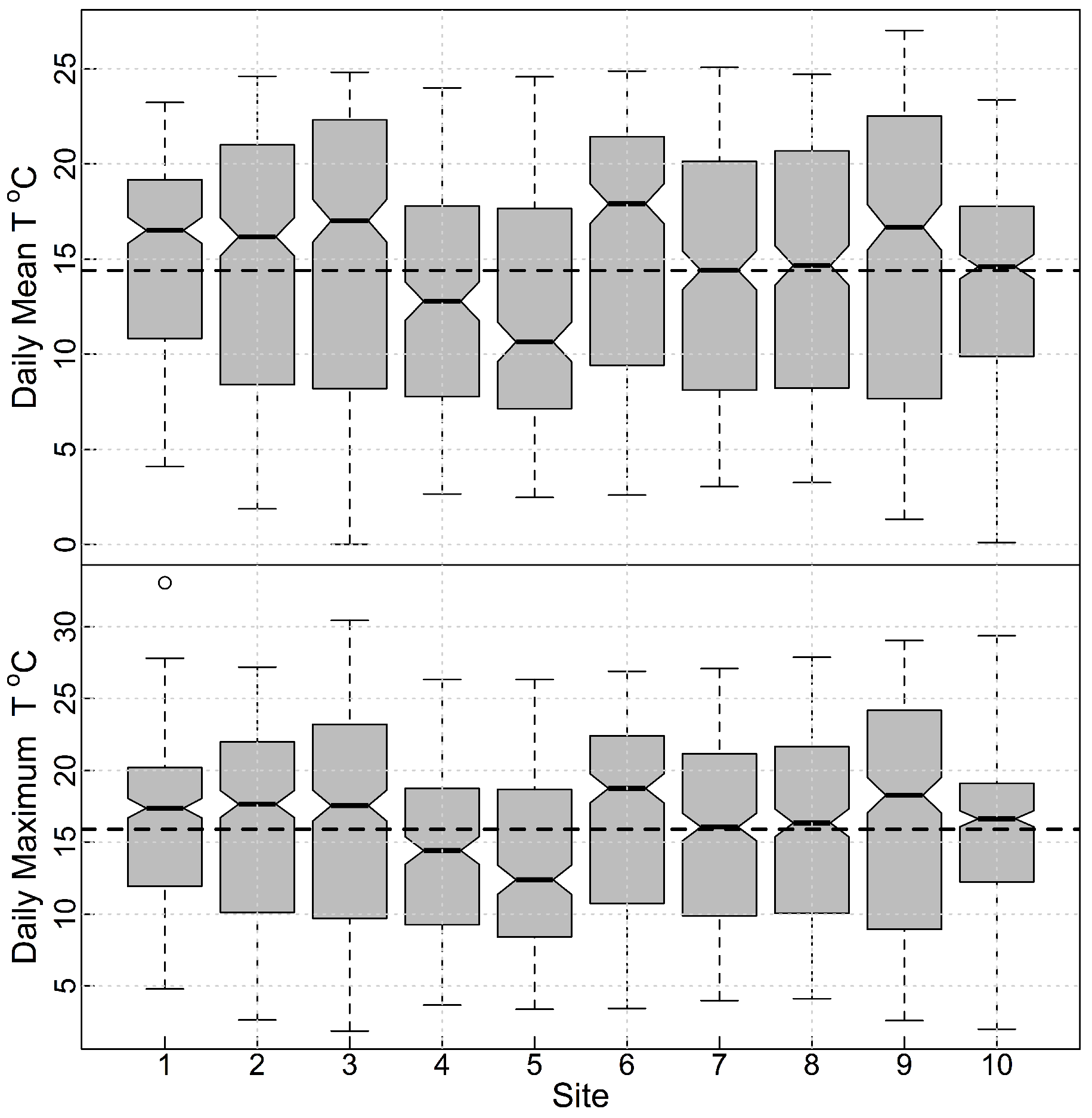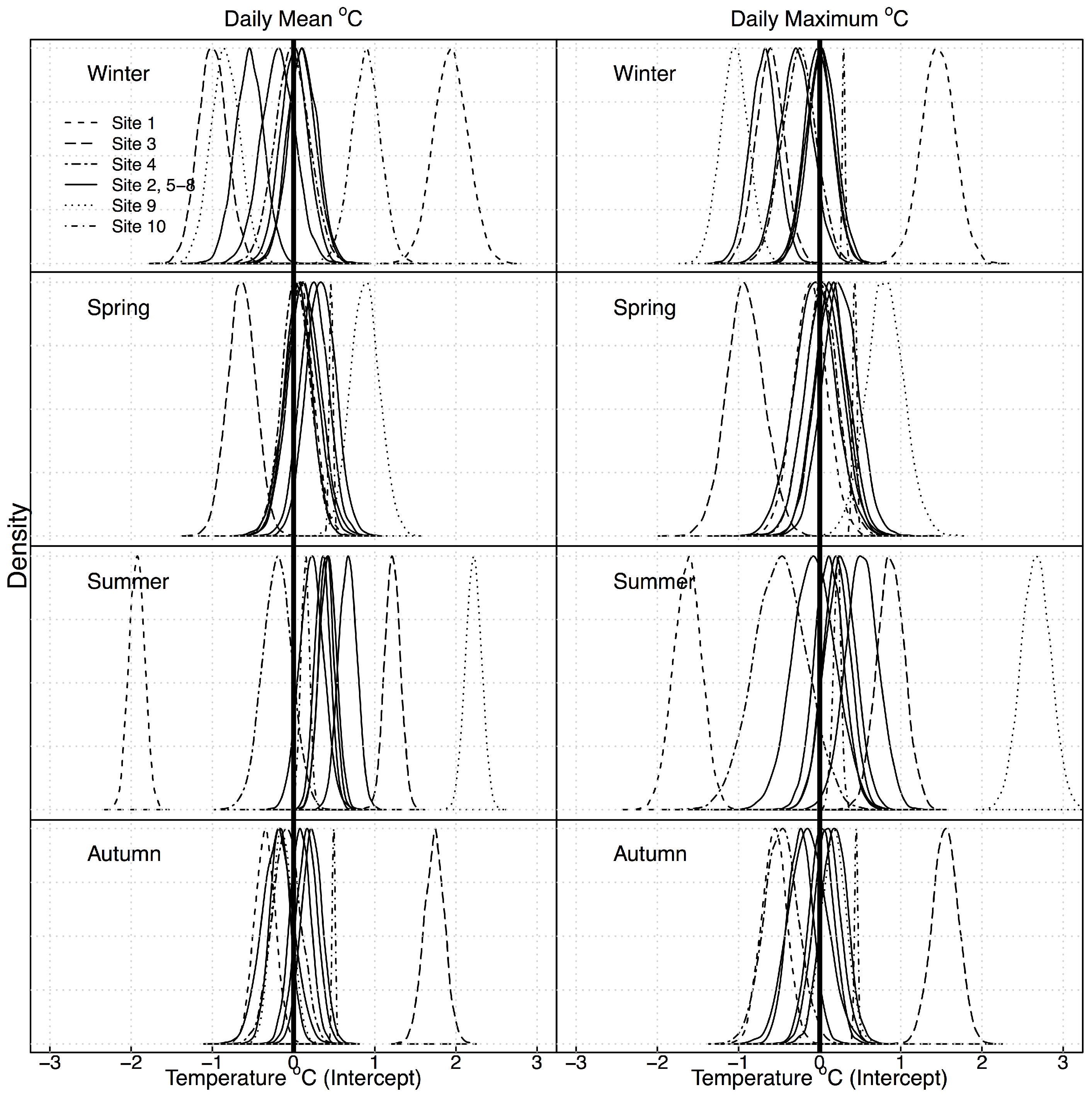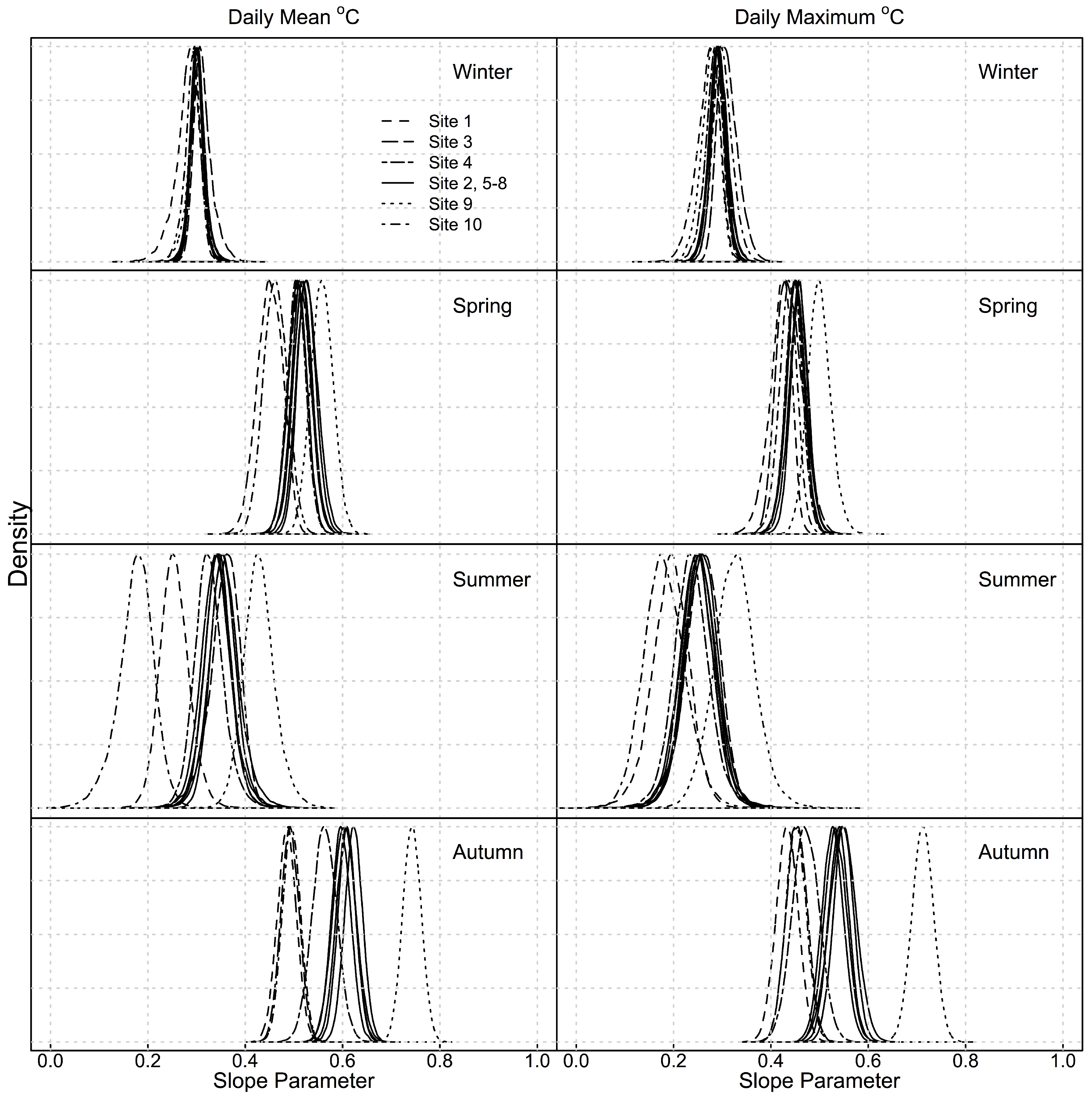1. Introduction
Stream temperature (
) is an important water quality parameter that has direct effects on a wide range of important processes in rivers. It plays a significant role in freshwater ecosystems through direct and indirect impacts on aquatic organisms [
1,
2,
3]. Stream temperature directly affects the timing of fish spawning [
4], controls freshwater mussel life cycles [
5], and high
can have lethal affects on most organisms. Stream temperature indirectly controls overall stream metabolism through impacts on nutrient cycling and dissolved O
concentrations [
6,
7]. Variation of
creates heterogeneity of aquatic habitat and influences the distribution of fish and other organisms in a river network [
8]. Furthermore,
has been rising along with global air temperatures throughout most of the world [
9,
10], and will likely have a significant impact on many fish species, such as salmonids and trout, that are sensitive to high
as well as other aquatic organisms [
11]. For instance, in North America, freshwater mussels (Unionids) are a highly threatened group of organisms [
5] that are vulnerable to increasing
[
12]. Daraio et al. [
13] indicated that thermal thresholds for mussels will be exceeded more frequently as a result of land-use and climate change in many areas of a watershed in North Carolina, USA, but not uniformly within the basin. Understanding
variation over a wide range of scales will help conservation efforts and management of aquatic habitat and fisheries [
14].
The fundamental physical processes that determine heat fluxes that control
in streams are relatively well understood (see Webb et al. and Garner et al. [
1,
15] for reviews). However, the complexity of river systems makes it difficult to understand dominant mechanisms that lead to stream temperature variability. Stream temperature can vary at a wide range of spatial scales, including the basin scale, reach scale, and laterally across the width of a river [
1,
16,
17,
18,
19,
20].
Some systems show little variation in stream temperature. Groundwater fed streams tend to show less spatial variation of
, and groundwater can be of importance across at local scales [
21,
22]. For example, gaining streams showed less diurnal
variation as a result of the influx of groundwater, which is at a relatively constant
[
23]. In contrast, alpine river systems have a high degree of variation in
due to the influence of snowmelt, ice-melt, and hydroclimatological conditions [
24,
25]. Stream temperature increased by greater than 8
C over a 1 km reach in glacial fed river and extreme rainfall decreased temperatures up to 10
C [
26]. River systems with
variation between these extremes are impacted by a wide range of processes: land-use, clear-cutting, and forest fires impact
[
1]. Stream temperature after the occurrence of wildfires in the Canadian Rocky Mountains increased both mean daily and daily maximum
by up to 3
C [
27]. Small watersheds in urban areas produce
surges after storm events as runoff travels over heated impervious surfaces [
28]. However, the degree to which runoff adds heat is dependent upon characteristics of the rainfall event and weather conditions prior to the event, e.g., air and dew point temperatures and duration of rainfall [
29]. Riparian cover contributes to spatial heterogeneity of
at local scales within stream networks [
30]. Interactions between local and watershed scale processes makes it difficult to parse and quantify the relative contribution of potential sources of variability in
. Djebou and Singh [
31] use an entropy-based index to quantify patterns of precipitation, land-cover, and streamflow across a watershed, and such an approach may be useful to assess stream temperature variability as well.
Our growing understanding of
and
variation and its importance to river ecosystems has led to an increased interest in the use of
models to aid in conservation and management decisions. Many studies have shown a strong relationship between
and
[
10,
21,
32], which is most likely because the heat fluxes that determine
and
are similar. For instance, Johnson et al. [
33] found that 84–94% of variance in
at the daily scale was explained by varaiance in
. However, transfer of heat energy from air to water only accounts for a small portion of energy exchanges affecting stream temperature [
34]. While it is likely that regional models of
based on
do not capture the variation in local scale
and fail to represent small-scale thermal variation [
35], it is possible that variations in relationships between
and
could point to sources of variation in
at local scales.
There have been relatively few studies that attempt to quantify differences in the relationship between
and
. Rice and Jastram [
36] used principal components analysis to examine trends in air and water temperature based on landscape scale factors such as dominant land cover and presence of major dams. Stefan and Preud’Homme [
37] performed linear regression of
with
in the Upper Mississippi River basin at 11 sites, with scales ranging from 137 km
to 400,000 km
, and found that regression coefficients and variances of coefficients differed across sites. Stefan and Preud’Homme [
37] explained differences in coefficients to be a result of local features in the river network, such as impoundments, lakes, wetlands, industrial releases, and shading. Caissie et al. [
38] found that regression models relating
to
only worked on a weekly time scale and varied on a seasonal basis, which seems to suggest the dominance of microclimate in driving
variation.
We conjecture that measuring differences in the relationship of and will help identify factors most important to variability at small scales. In this paper, we use Bayesian hierarchical regression analyses to quantify variation in and its relationship with and then attempt to relate it to site specific characteristics within the basin. The objectives were to (1) describe the variability of in a small urbanized watershed at a daily time scale; and (2) determine and compare posterior distributions of estimated regression parameters for and at 10 sites within the basin at a daily time scale using Bayesian regression techniques. Objective (2) will provide a measure of the variability of and the relationship between and in this small watershed.
3. Results
Mean daily
over the time period of data collection was
C , and mean daily maximum
was
C. Mean daily
over the time period of data collection was
C, and mean daily maximum
was
C. Mean daily and mean daily maximum
showed significant variation within the watershed (
Figure 3). Variation in daily mean
was similar at all sites (
Table 2) with sites 3 and 9 showing the greatest variation in daily mean and daily maximum
. Site 1 had the lowest variance for daily mean and daily maximum
. While
at sites were highly correlated (
Table 2), there was no clear trend in correlation as a function of the distance between sites. Site 10 showed the weakest relationship with other sites, but this did not seem to be a function of distance since correlations for site 10 were stronger with site 1 (outlet) than with all other sites in the reach.
Daily mean
was strongly correlated with daily mean
at all sites, and daily maximum
and maximum
were also strongly correlated at all sites (
Table 3). The correlations were significant for all basins for mean temperatures and all basins except basin 10 (where
) for maximum temperatures. Pearson’s correlation coefficients for mean
and mean
ranged from 0.0 to 0.50 over the 10 basins, but none of the correlations were significant at the
level. Stream temperatures at site 9 indicated the greatest correlation (0.48) with
, and this site was located at the outlet of Abbott’s Pond that is not shaded and is affected by solar radiation. A relatively high correlation existed at site 7,
, which is a slow flowing less shaded area of the stream. There were no significant relationships between
with
Q,
, or
V. There was no apparent relationship between
P and
, and there was no difference in the correlation between
and
on days with precipitation (
) and days without precipitation (
).
Estimates of slope parameters (
) for regressions on relationships between
and
for daily mean and daily maximum showed variation within the watershed (
Figure 4,
Table 4). The average slope for all sites combined was
. The variation in slope parameter for all sites combined was much greater than the slope parameter (
) for each individual site (≈0.01 at all sites). The slope parameters for both mean and maximum
with
were lowest at sites 1 and 10, representing the outlet and the uppermost section of the watershed, respectively. Slope parameters were largest at sites 3 and 9, which is discussed above. The data logger at site 3 was inside a drainage conduit, which ran under a parking lot, fed from a small retention pond with some wetland vegetation (
Figure 2). The retention pond has some shading from low lying wetland vegetation and was lined with large stones.imum)
for all sites combined. Differences in mean
between sites can be compared in
Table 5.
differences within ±0.4
C are not considered to be physically significant given the limits of accuracy of the data loggers. Sites 3 and 9 were warmer on average than other sites, and sites 4 and 10 were cooler. The same trends were observed for daily maximum
for both slope and intercept parameters.
Differences in daily mean temperature between some sites were
C in the summer and
C in the winter (
Table 6). There were large temperature differences between sites 9 and 10, which were only 150 m apart, because of the heating that occurred in Abbott’s pond just upstream from site 9. Estimated intercept parameters indicated that mean
had its greatest variation between sites in the summer within the watershed for both daily mean and daily maximum temperatures (
Figure 5), while seasonal mean daily
and mean daily
had the least amount of variation in the summer (
Table 7). Seasonal mean
was significantly different (
) at several sites within the watershed from mean
for all sites over the entire watershed (
Table 6). Mean and maximum daily
was greater at sites 1 and 10 in the winter, but cooler at these sites in the summer. Site 10 was cooler in spring and autumn as well. Site 9 was warmer in the spring and summer and cooler in the winter compared to other sites. Site 3 was cooler in the winter and spring, but warmer in the summer and autumn. Variation in daily mean and daily maximum
was greatest in winter and spring overall within sites (width of distributions in
Figure 5), and greatest in winter and summer between sites. Daily mean and maximum
varied more uniformly over the watershed in the spring when
was more uniform throughout the watershed. Site 10 had the least variation in daily maximum
in all seasons, and the least variation in daily mean in all seasons except winter compared to all other sites.
Posterior distributions for slope parameters (
) for regressions varied significantly by season (
Figure 6). The strongest relationships between
and
occurred in the autumn and spring. Relationships were weakest in the winter and summer but showed the greatest variation in summer both within and between sites, contrary to the variation in measured
. Between site variance was greater than within site variance at all sites in spring, summer and autumn (
Figure 6). Sites 1 and 10 showed the weakest relationships with air temperature, and site 9 showed the strongest relationship between daily mean (max)
and daily mean (max)
with
(
) for all seasons combined. The weakest relationship with daily mean (max)
was at site 1 in the summer where
(
).
4. Discussion
The significant variation in daily mean and daily maximum
within the 1.2 km reach of Chestnut Branch is consistent with results from other small stream networks [
35]. Over the entire year, mean daily temperature was similar at all sites except site 10, where mean temperature was just over 1
C cooler. Mean daily temperature was cooler at site 10 compared each of the other sites as well. The slope of the regression line of
and
at site 10,
, was significantly lower than at other sites except for site 1 over the entire year. Sites 1 and 10 had the least variation in
compared with other sites. Furthermore, sites 1 and 10 showed less variation and the greatest temperature differences compared to other sites in winter and summer. These two sites were heavily shaded in the summer and received a greater proportion of flow from groundwater relative to other sites. Site 1 receives inflow from Rowan pond, which is groundwater fed and flows into Chestnut Branch, except at times of high flow. Site 10 was just downstream from where perennial flow begins. These factors help explain the lower variance observed at these sites. For example, Constantz [
23] found that variation in
was 11% in gaining reaches and 30% in losing reaches. Riparian cover tends to moderate diurnal variations and keep maximum temperatures lower than unshaded areas [
43,
44]. It is not likely that the small differences in flow, apart from the contribution of groundwater, impacted the observed differences in
. MacDonald et al. [
45] found that discharge was important in explaining inter-annual
variation in a headwater streams, in particular moisture conditions at the watershed scale (10 km
). However, there were no observed relationships between stream flow and
, and it is not likely that
Q impacts
in Chestnut Branch (2 km
). This is likely due in part to the small size of the watershed, but there is evidence that the duration of temperature exceedance is impacted by stream flow more than daily mean
[
13].
Stream temperature at sites 1 and 10 also showed the weakest relationship (low
) with
based on regressions compared with other sites over the entire year and in spring and summer. While lower variance in daily mean
may indicate the influence of groundwater and/or riparian cover, the weaker relationship with
indicates that factors other than those that affect
are controlling
at these sites. It is likely that interactions with groundwater influx and shading in these reaches impacted the relationship with
, particularly in the summer. Groundwater temperatures are relatively constant and are close to the average annual air temperature in a region. Stream temperature has been shown to be less responsive to
in colder tributaries [
35], and it seems likely that this is the case within segments of the same stream. Additionally, these sites have dense riparian cover, which leads to a microclimate different that average bulk meteorological conditions. These effects seemed less apparent for maximum temperatures where the means of the slope parameter tended to converge, i.e., less between site variation, for maximum temperature. It seems that relationship of maximum
with maximum
is more uniform.
The site with the warmest mean daily temperatures (site 9) had the strongest relationship (
) with air temperature, and this site had the greatest variation in daily mean
. Site 9 was located downstream of the outlet of Abbott’s pond, with little cover, and is most likely to have conditions throughout the year similar to bulk meteorological conditions measured at the weather station. The lack of riparian cover over the pond allows the loss of heat at night to be a function primarily of the temperature gradient between the water and air [
46], thus a stronger relationship of
with
.
The greatest differences in daily mean
between sites occurred in the summer. Spatial
variability between sites was greatest in the summer, and spatial variability of
was most uniform in winter and spring. Relationships between
and
were strongest in spring and autumn and weakest in summer at all sites, but there was greater variability in slope parameters in summer between sites for relationship with
. These results support the conclusion that micro-climate was more important in the summer when shading can have a larger impact on heat fluxes. For example, Rutherford et al. [
47] indicated that differential heating due to absorption of solar radiation by riparian vegetation affects stream temperature. Results indicated a correlation between solar radiation and
, but correlations were not significant (
) at all sites. Correlations between
and
were greatest at sites 7 and 9. Site 9 was near the outlet of Abbott’s pond, which is clearly impacted by solar radiation, but the correlation at site 7, which was <100 m downstream from site 8 does was not likely physically significant. Micro-climate factors, such as wind speed, relative humidity, and solar radiation, at sites are likely to have effects at these sites, especially in smaller basins and at sheltered sites [
48,
49]. Bulk measurements for these meteorological variables from a single weather station are less likely to show consistent relationships with
between sites.
The stronger relationship with
and higher between site variance in slope parameters in autumn can possibly be explained in part by the major changes in riparian cover that occur during the autumn season. The autumn months were September, October, and November, and leaves are fully shed from trees by mid- to late-October in southern New Jersey. Therefore, autumn represents a time period with both significant cover in some areas and with little cover after leaf fall. Additionally, leaf fall occurs non-uniformly along the stream, which likely impacts heat flux, and the accumulation of leaf litter in the stream varies within the basin. While leaf litter decomposition is an important component for stream metabolism [
50] and impacts heat flux in terrestrial systems [
51], it is not clear how it impacts stream temperature. Woody debris and small scale morphological features have been shown to increase temperature variability [
52], though these factors are not highly variable in Chestnut Branch.
Relative values and variation on slope parameters for relationships of and provided an indication of the potential that different processes were affecting stream temperature between sites. The 10 sites chosen represented a variety of known conditions along the stream, and the variance in for regressions using data from all sites within the basin was relatively high compared to variance in for each site.
The solar radiation and groundwater inflow were found to have the most significant impact on heat budget in a 116 km
watershed in Indiana [
53]. Differences at this temporal scale, regressions of
with
are able to distinguish stream temperature variations, but, at a season scale, regressions provide more info.
A detailed spatial analysis as described by Isaak et al. [
54] was beyond the scope of this study. However, it is likely that differing characteristics between sites were more important in the summer when microclimate is, this is different. Kanno et al. [
35] found that
variability primarily occurred between stream segments as opposed to within a stream segment, i.e., after tributary confluences.
5. Conclusions
The Bayesian hierarchical analysis as applied to the Chestnut Branch watershed provides a straightforward method for identifying local scale variability in the relationship between stream temperature and air temperature. This approach can be applied at relatively small scales to identify areas where different local scale processes may be contributing to the response of stream temperature to different drivers in daily to seasonal time frames. Application of such information can be important for management and conservation of local scale habitat with regard to the potential impacts of land-use and climate change.
Steam temperature variation was lowest at sites with a greater amount of riparian cover that also had a relatively large proportion of flow from groundwater. These sites also showed the weakest relationship between and , suggesting a significant influence of groundwater influx and shading on the relationship. Stream temperature variation was greatest in the spring and autumn, and lowest in the summer. The relationship between and varied significantly by season both within and between sites. Relationships were strongest in spring and autumn and weakest in summer at all sites, but greater variability in slope parameters was found between sites in summer. Greater variability in slope parameters and weaker relationships between and indicate that micro-climate and/or local characteristics of the basin impact most in the summer. In general, these results support the conclusion that riparian shading impacts the effect of on , and that open areas without cover are more likely to have meteorologic conditions similar to bulk conditions. Therefore, shows a stronger relationship with measured at these sites, though these impacts could not be fully quantified at the daily time scale. Additionally, at the daily scale, the impacts of watershed characteristics and rainfall on were not clear. However, this does not imply that these are not important factors affecting . Analysis at a finer time resolution is required to quantify these effects, and the posterior distributions for slope parameters will help to locate areas where site-specific factors are more likely to impact . The one-minute collected and used in this study will be used for further analysis of relationships between and other factors, such as land-use/land cover and rainfall, at these sites.
